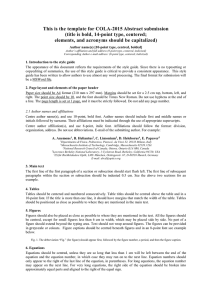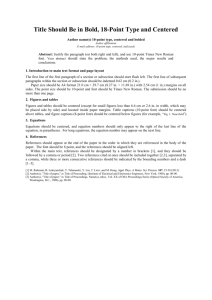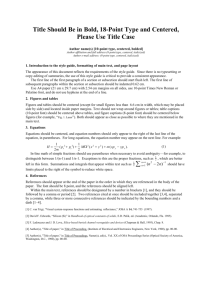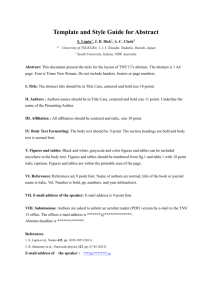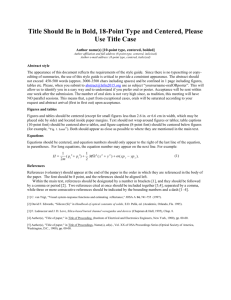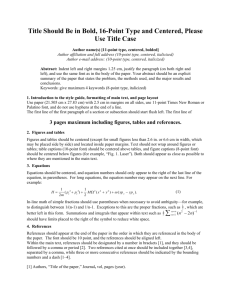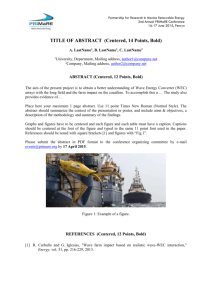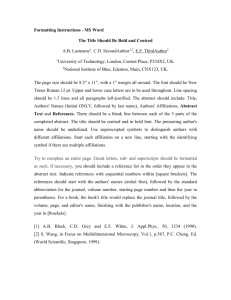template
advertisement
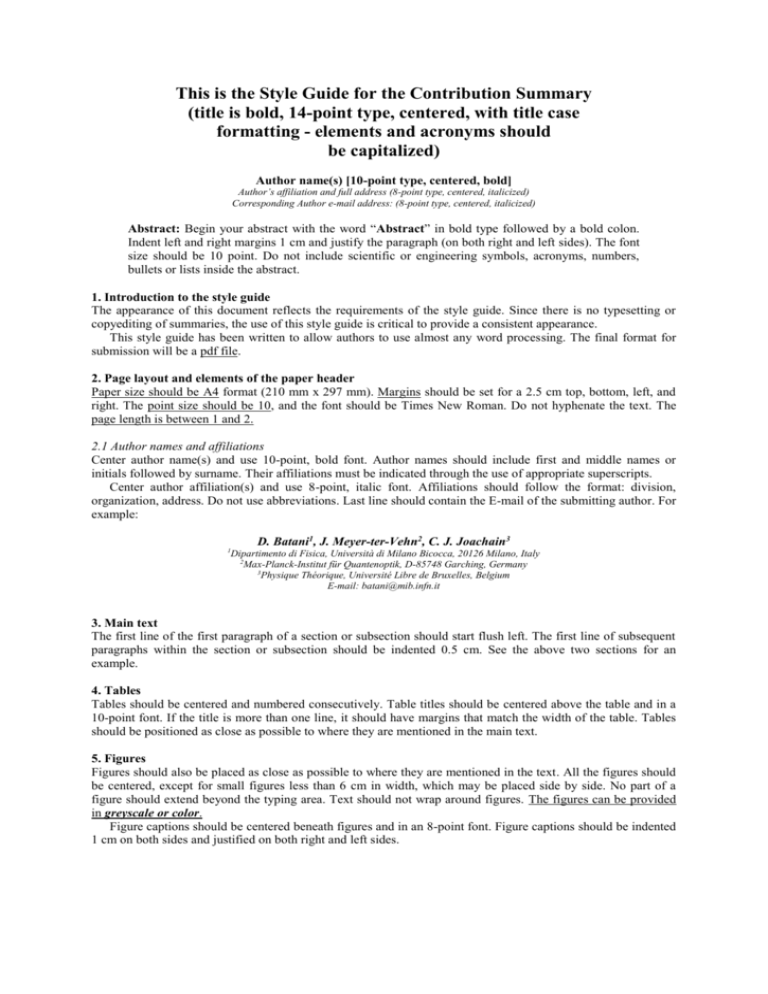
This is the Style Guide for the Contribution Summary (title is bold, 14-point type, centered, with title case formatting - elements and acronyms should be capitalized) Author name(s) [10-point type, centered, bold] Author’s affiliation and full address (8-point type, centered, italicized) Corresponding Author e-mail address: (8-point type, centered, italicized) Abstract: Begin your abstract with the word “Abstract” in bold type followed by a bold colon. Indent left and right margins 1 cm and justify the paragraph (on both right and left sides). The font size should be 10 point. Do not include scientific or engineering symbols, acronyms, numbers, bullets or lists inside the abstract. 1. Introduction to the style guide The appearance of this document reflects the requirements of the style guide. Since there is no typesetting or copyediting of summaries, the use of this style guide is critical to provide a consistent appearance. This style guide has been written to allow authors to use almost any word processing. The final format for submission will be a pdf file. 2. Page layout and elements of the paper header Paper size should be A4 format (210 mm x 297 mm). Margins should be set for a 2.5 cm top, bottom, left, and right. The point size should be 10, and the font should be Times New Roman. Do not hyphenate the text. The page length is between 1 and 2. 2.1 Author names and affiliations Center author name(s) and use 10-point, bold font. Author names should include first and middle names or initials followed by surname. Their affiliations must be indicated through the use of appropriate superscripts. Center author affiliation(s) and use 8-point, italic font. Affiliations should follow the format: division, organization, address. Do not use abbreviations. Last line should contain the E-mail of the submitting author. For example: D. Batani1, J. Meyer-ter-Vehn2, C. J. Joachain3 1 Dipartimento di Fisica, Università di Milano Bicocca, 20126 Milano, Italy 2 Max-Planck-Institut für Quantenoptik, D-85748 Garching, Germany 3 Physique Théorique, Université Libre de Bruxelles, Belgium E-mail: batani@mib.infn.it 3. Main text The first line of the first paragraph of a section or subsection should start flush left. The first line of subsequent paragraphs within the section or subsection should be indented 0.5 cm. See the above two sections for an example. 4. Tables Tables should be centered and numbered consecutively. Table titles should be centered above the table and in a 10-point font. If the title is more than one line, it should have margins that match the width of the table. Tables should be positioned as close as possible to where they are mentioned in the main text. 5. Figures Figures should also be placed as close as possible to where they are mentioned in the text. All the figures should be centered, except for small figures less than 6 cm in width, which may be placed side by side. No part of a figure should extend beyond the typing area. Text should not wrap around figures. The figures can be provided in greyscale or color. Figure captions should be centered beneath figures and in an 8-point font. Figure captions should be indented 1 cm on both sides and justified on both right and left sides. Fig. 1. The abbreviation “Fig.” (for figure) should appear first, followed by the figure number, a period, and then the figure caption. 6. Equations Equations should be centered, unless they are so long that less than 1 cm will be left between the end of the equation and the equation number, in which case they may run on to the next line. Equation numbers should only appear to the right of the last line of the equation, in parenthesis. For long equations, the equation number may appear on the next line. For very long equations, the right side of the equation should be broken into approximately equal parts and aligned to the right of the equal sign. 7. References References should appear at the end of the article in the order in which they are referenced in the body of the paper. The font should be 8 point, and the references should be aligned left. Within the main text, references should be designated by a number in brackets [1], and they should precede a comma or period [2]. Two references cited at once should be included together [3,4], separated by a comma, while three or more consecutive references should be indicated by the bounding numbers and a dash [1–4]. For journal articles, authors are listed first, followed by the article’s full title in quotes, the journal’s title abbreviation, the volume number in bold, page number, and the year in parentheses. 1 J. Itatani, D. Zeidler, J. Levesque, D. M. Villeneuve, and P. B. Corkum, “Controlling High Harmonic Generation with Molecular Wave Packets,” Phys. Rev. Lett. 94, 123902 (2005). For citation of a book as a whole: authors, followed by title in italics, and publisher, city, and year in parenthesis. 2 G. P. Agrawal, Nonlinear Fiber Optics, 3rd. ed., (Academic Press, Boston, 2001). For citation of a book chapter, authors are listed first, followed by book title in italics, editors, and publisher, city, and year in parenthesis. Chapter number may be added if applicable. 3 R. Kienberger and F. Krausz in, Few-cycle laser pulse generation and its applications, F. X. Kärtner ed. (Springer Verlag, Berlin, 2004). For citation of proceedings, follow the individual proceedings format: 4 Author(s), “Title of paper,” in Title of Proceeding, Ed(s) Name(s), Proc. format …… 8. Miscellaneous Acknowledgments, job descriptions and footnotes should not be included in the summary.
